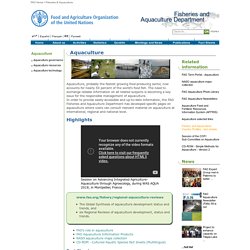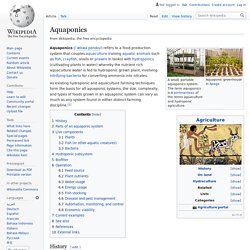

Aquaponic Farming. Fisheries & Aquaculture - Aquaculture. Aquaculture, probably the fastest growing food-producing sector, now accounts for nearly 50 percent of the world's food fish.

The need to exchange reliable information on all related subjects is becoming a key issue for the responsible management of aquaculture.In order to provide easily-accessible and up-to-date information, the FAO Fisheries and Aquaculture Department has developed specific pages on aquaculture where users can consult relevant material on aquaculture at international, regional and national level. The Global Synthesis of aquaculture development status and trends, andsix Regional Reviews of aquaculture development, status and trends. Fact Sheets Aquaculture Fact Sheets contain a synthesis of detailed information on specific subjects and include related statistics, graphics (GIS maps, images, figures, etc.) and profiles. Aquaponics Basics. Aquaponics. System combining aquaculture with hydroponics in A symbiotic environment A small, portable aquaponics system.

The term aquaponics is A portmanteau of the terms aquaculture and hydroponic agriculture. Aquaponic greenhouse in Apaga Aquaponics () refers to a food production system that couples aquaculture (raising aquatic animals such as fish, crayfish, snails or prawns in tanks) with hydroponics (cultivating plants in water) whereby the nutrient rich aquaculture water is fed to hydroponic grown plant, involving nitrifying bacteria for converting ammonia into nitrates. As existing hydroponic and aquaculture farming techniques form the basis for all aquaponic systems, the size, complexity, and types of foods grown in an aquaponic system can vary as much as any system found in either distinct farming discipline.[1]